A reference designator unambiguously identifies the location of a component within an electrical schematic or on a printed circuit board. The reference designator usually consists of one or two letters followed by a number, e.g. C3, D1, R4, U15. The number is sometimes followed by a letter, indicating that components are grouped or matched with each other, e.g. R17A, R17B. The IEEE 315 standard contains a list of Class Designation Letters to use for electrical and electronic assemblies. For example, the letter R is a reference prefix for the resistors of an assembly, C for capacitors, K for relays.
IEEE 200-1975 or "Standard Reference Designations for Electrical and Electronics Parts and Equipments" is a standard that was used to define referencing naming systems for collections of electronic equipment. IEEE 200 was ratified in 1975. The IEEE renewed the standard in the 1990s, but withdrew it from active support shortly thereafter. This document also has an ANSI document number, ANSI Y32.16-1975.
This standard codified information from, among other sources, a United States military standard MIL-STD-16 which dates back to at least the 1950s in American industry.
To replace IEEE 200–1975, ASME, a standards body for mechanical engineers, initiated the new standard ASME Y14.44-2008. This standard, along with IEEE 315–1975, provide the electrical designer with guidance on how to properly reference and annotate everything from a single circuit board to a collection of complete enclosures.
ASME Y14.44-2008 [1] and IEEE 315-1975 [2] define how to reference and annotate components of electronic devices.
It breaks down a system into units, and then any number of sub-assemblies. The unit is the highest level of demarcation in a system and is always a numeral. Subsequent demarcation are called assemblies and always have the Class Letter "A" as a prefix following by a sequential number starting with 1. Any number of sub-assemblies may be defined until finally reaching the component. Note that IEEE-315-1975 [2] defines separate class designation letters for separable assemblies (class designation 'A') and inseparable assemblies (class designation 'U'). Inseparable assemblies—i.e., "items which are ordinarily replaced as a single item of supply" [2] —are typically treated as components in this referencing scheme.
Examples:
Especially valuable is the method of referencing and annotating cables plus their connectors within and outside assemblies. Examples:
A cable connecting these two might be:
Connectors on this cable would be designated:
ASME Y14.44-2008 continues the convention of Plug P and Jack J when assigning references for electrical connectors in assemblies where a J (or jack) is the more fixed and P (or plug) is the less fixed of a connector pair, without regard to the gender of the connector contacts.
The construction of reference designators is covered by IEEE 200-1975/ANSI Y32.16-1975 [3] (replaced by ASME Y14.44-2008 [1] ) and IEEE-315-1975. [2]
The table below lists designators commonly used, and does not necessarily comply with standards. For modern use, designators are often simplified towards shorter designators, because it requires less space on silkscreens.
| Designator | Component type | Modern use | |
|---|---|---|---|
| A | Separable assembly or sub-assembly (e.g. printed circuit assembly) | ||
| AT | Attenuator or isolator | ||
| BR | Bridge rectifier (four diodes in a package) | often changed to "D" for diode | |
| BT | Battery | often shortened to "B" | |
| C | Capacitor | ||
| CB | Circuit Breaker | ||
| CN | Capacitor network | may be simplified to "C" for capacitor | |
| D, CR | Diode (all types, including LED), thyristor | "D" is preferred for various types of diodes | |
| DL | Delay line | ||
| DS | Display, general light source, lamp, signal light | ||
| F | Fuse | ||
| FB | Ferrite bead | sometimes changed to "L" for inductor, though "E" was used in the currently inactive standard IEEE 315 (see Clause 22.4). | |
| FD | Fiducial | ||
| FL | Filter | ||
| G | Generator or oscillator | ||
| GL | Graphical logo | ||
| GN | General network | ||
| H | Hardware, e.g., screws, nuts, washers | sometimes hardware is expanded to "HW" | |
| HY | Circulator or directional coupler | ||
| IR | Infrared diode | often changed to "D" for diode | |
| J | Jack (least-movable connector of a connector pair), jack connector (connector may have "male" pin contacts and/or "female" socket contacts) | all types of connectors, including pin headers. | |
| JP | Jumper (link) | ||
| K | Relay or contactor | ||
| L | Inductor or coil or ferrite bead | ||
| LS | Loudspeaker or buzzer | ||
| M | Motor | ||
| MK | Microphone | ||
| MP | Mechanical part (including screws and fasteners) | ||
| OP | Opto-isolator | often changed to "U" for IC | |
| P | Plug (most-movable connector of a connector pair), plug connector (connector may have "male" pin contacts and/or "female" socket contacts) | ||
| PS | Power supply | ||
| Q | Transistor (all types) | ||
| R | Resistor | ||
| RN | Resistor network | sometimes simplified to "R" for resistor, or "N" for network | |
| RT | Thermistor | sometimes simplified to "R" for resistor | |
| RV | Varistor, variable resistor | ||
| S | Switch (all types, including buttons) | sometimes SW is erroneously used | |
| SA | Spark Arrester | ||
| T | Transformer | sometimes changed to "L" for inductor | |
| TC | Thermocouple | ||
| TP | Test point | ||
| TUN | Tuner | ||
| U, IC | Integrated circuit (IC) | shorter "U" (unit) is preferred instead of "IC" | |
| V | Vacuum tube | ||
| VR | Voltage regulator (voltage reference), or variable resistor (potentiometer / trimmer / rheostat) | voltage regulators are often "U" for IC, pots and trimmers often "R" for resistor | |
| X | Socket connector for another item not P or J, paired with the letter symbol for that item (XV for vacuum tube socket, XF for fuse holder, XA for printed circuit assembly connector, XU for integrated circuit connector, XDS for light socket, etc.) | ||
| X, XTAL, Y | Crystal, ceramic resonator, powered oscillator |

The American National Standards Institute is a private nonprofit organization that oversees the development of voluntary consensus standards for products, services, processes, systems, and personnel in the United States. The organization also coordinates U.S. standards with international standards so that American products can be used worldwide.

A logic gate is a device that performs a Boolean function, a logical operation performed on one or more binary inputs that produces a single binary output. Depending on the context, the term may refer to an ideal logic gate, one that has, for instance, zero rise time and unlimited fan-out, or it may refer to a non-ideal physical device.

Microelectronics is a subfield of electronics. As the name suggests, microelectronics relates to the study and manufacture of very small electronic designs and components. Usually, but not always, this means micrometre-scale or smaller. These devices are typically made from semiconductor materials. Many components of a normal electronic design are available in a microelectronic equivalent. These include transistors, capacitors, inductors, resistors, diodes and (naturally) insulators and conductors can all be found in microelectronic devices. Unique wiring techniques such as wire bonding are also often used in microelectronics because of the unusually small size of the components, leads and pads. This technique requires specialized equipment and is expensive.
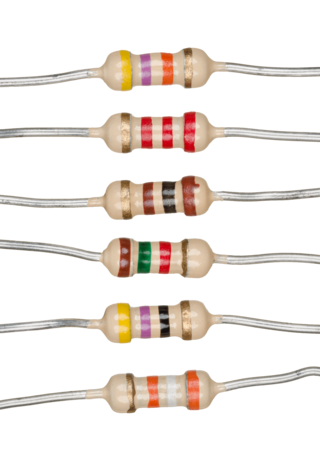
A resistor is a passive two-terminal electrical component that implements electrical resistance as a circuit element. In electronic circuits, resistors are used to reduce current flow, adjust signal levels, to divide voltages, bias active elements, and terminate transmission lines, among other uses. High-power resistors that can dissipate many watts of electrical power as heat may be used as part of motor controls, in power distribution systems, or as test loads for generators. Fixed resistors have resistances that only change slightly with temperature, time or operating voltage. Variable resistors can be used to adjust circuit elements, or as sensing devices for heat, light, humidity, force, or chemical activity.
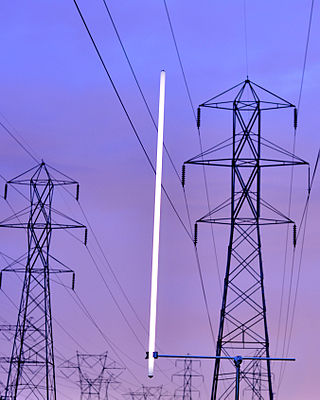
Capacitive coupling is the transfer of energy within an electrical network or between distant networks by means of displacement current between circuit(s) nodes, induced by the electric field. This coupling can have an intentional or accidental effect.
Transistor–transistor logic (TTL) is a logic family built from bipolar junction transistors. Its name signifies that transistors perform both the logic function and the amplifying function, as opposed to earlier resistor–transistor logic (RTL) and diode–transistor logic (DTL).

The electrical resistance of an object is a measure of its opposition to the flow of electric current. Its reciprocal quantity is electrical conductance, measuring the ease with which an electric current passes. Electrical resistance shares some conceptual parallels with mechanical friction. The SI unit of electrical resistance is the ohm, while electrical conductance is measured in siemens (S).

Components of an electrical circuit are electrically connected if an electric current can run between them through an electrical conductor. An electrical connector is an electromechanical device used to create an electrical connection between parts of an electrical circuit, or between different electrical circuits, thereby joining them into a larger circuit.

Electronic test equipment is used to create signals and capture responses from electronic devices under test (DUTs). In this way, the proper operation of the DUT can be proven or faults in the device can be traced. Use of electronic test equipment is essential to any serious work on electronics systems.
This is an index of articles relating to electronics and electricity or natural electricity and things that run on electricity and things that use or conduct electricity.

A gyrator is a passive, linear, lossless, two-port electrical network element proposed in 1948 by Bernard D. H. Tellegen as a hypothetical fifth linear element after the resistor, capacitor, inductor and ideal transformer. Unlike the four conventional elements, the gyrator is non-reciprocal. Gyrators permit network realizations of two-(or-more)-port devices which cannot be realized with just the four conventional elements. In particular, gyrators make possible network realizations of isolators and circulators. Gyrators do not however change the range of one-port devices that can be realized. Although the gyrator was conceived as a fifth linear element, its adoption makes both the ideal transformer and either the capacitor or inductor redundant. Thus the number of necessary linear elements is in fact reduced to three. Circuits that function as gyrators can be built with transistors and op-amps using feedback.
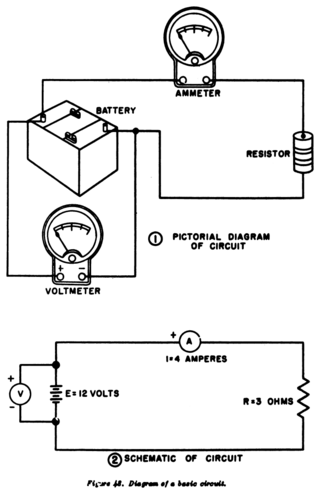
A circuit diagram is a graphical representation of an electrical circuit. A pictorial circuit diagram uses simple images of components, while a schematic diagram shows the components and interconnections of the circuit using standardized symbolic representations. The presentation of the interconnections between circuit components in the schematic diagram does not necessarily correspond to the physical arrangements in the finished device.
A DC-to-DC converter is an electronic circuit or electromechanical device that converts a source of direct current (DC) from one voltage level to another. It is a type of electric power converter. Power levels range from very low to very high.

In electrical and mechanical trades and manufacturing, each half of a pair of mating connectors or fasteners is conventionally assigned the designation male or female. The female connector is generally a receptacle that receives and holds the male connector. Alternative terminology such as plug and socket or jack are sometimes used, particularly for electrical connectors.

IC power-supply pins denote a voltage and current supply terminals in electric, electronics engineering, and in integrated circuit design. Integrated circuits (ICs) have at least two pins that connect to the power rails of the circuit in which they are installed. These are known as the power-supply pins. However, the labeling of the pins varies by IC family and manufacturer. The double subscript notation usually corresponds to a first letter in a given IC family (transistors) notation of the terminals.

An electronic component is any basic discrete electronic device or physical entity part of an electronic system used to affect electrons or their associated fields. Electronic components are mostly industrial products, available in a singular form and are not to be confused with electrical elements, which are conceptual abstractions representing idealized electronic components and elements. A datasheet for an electronic component is a technical document that provides detailed information about the component's specifications, characteristics, and performance.
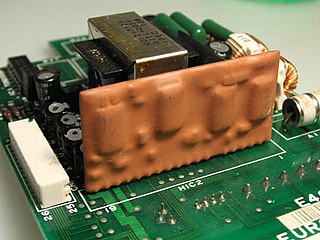
A hybrid integrated circuit (HIC), hybrid microcircuit, hybrid circuit or simply hybrid is a miniaturized electronic circuit constructed of individual devices, such as semiconductor devices and passive components, bonded to a substrate or printed circuit board (PCB). A PCB having components on a Printed Wiring Board (PWB) is not considered a true hybrid circuit according to the definition of MIL-PRF-38534.

An electronic symbol is a pictogram used to represent various electrical and electronic devices or functions, such as wires, batteries, resistors, and transistors, in a schematic diagram of an electrical or electronic circuit. These symbols are largely standardized internationally today, but may vary from country to country, or engineering discipline, based on traditional conventions.
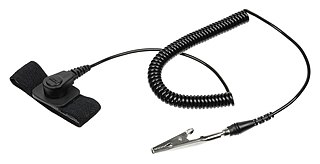
An antistatic device is any device that reduces, dampens, or otherwise inhibits electrostatic discharge, or ESD, which is the buildup or discharge of static electricity. ESD can damage electrical components such as computer hard drives, and even ignite flammable liquids and gases.

James L. Buie was an American scientist and inventor working for TRW Inc who developed transistor–transistor logic, a form of integrated circuit technology that became widely used early in the integrated circuit industry.